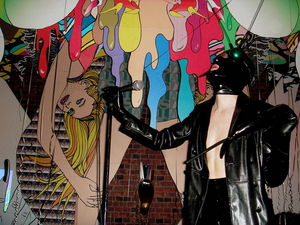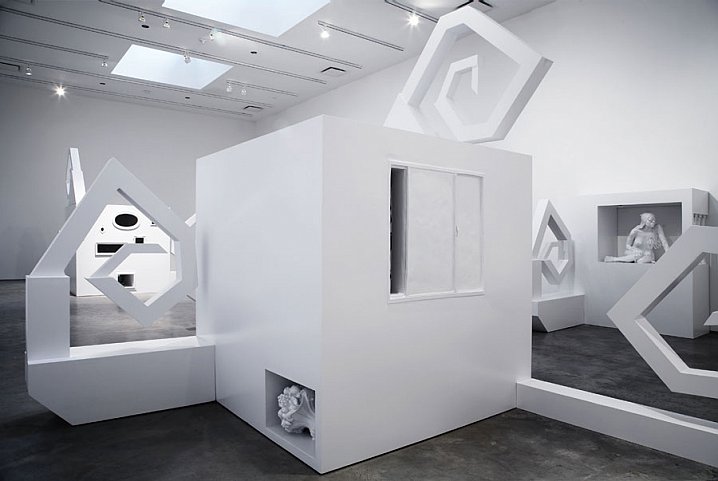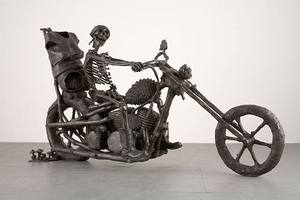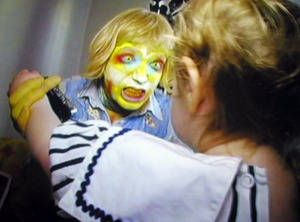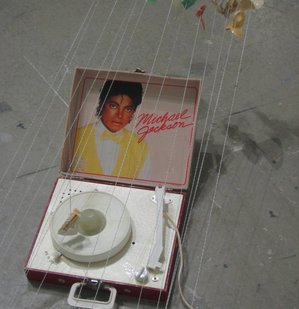This is an archive of the ArtCat Zine, 2007-2009. Please visit our new project, IDIOM.
December 2007
Dear Readers, Artcal Zine will not be posting new content this week due to the upcoming new year and related holidays. We will resume programming in early 2008, and in the meantime wish you all a happy new year.
Every year, this auspicious time rolls around as we challenge our willful memories to conjure up the outstanding moments that differ from last year’s and resolve to abandon certain baneful tendencies. The end of the year, whose certainty is as conclusive as, that’s right, death and taxes, also coincides with Miami Basel and the cornucopia of worthwhile and not so worthwhile art displays, contiguous fairs, pompous presentations and the inevitable Deitch party. I’m not even including Miami in my top ten this year, and not only because I didn’t go. This year was particularly fecund as all the major art world happenings coincided: the lavish Venice Biennale brought back the yachts and palazzo parties, Documenta 12 exploded in Kassel with another every-five-year grand scale presentation, the Münster Sculpture Project, which only occurs once a decade returned, and the increasingly brilliant Performa biennial of performance art saw its second incarnation as well as the usual suspects in Miami and Basel. With so many choices in New York alone another top-ten list to end the old and bring in the new means some discerning thought and careful culling. In no particular order, I present my list of the ten best things from this past year.
Performa returned this year for its second incarnation to emulate the previous effort with a bigger, more impressive variety of performances and events. One particularly notable performance (that I reviewed in a previous post), was Nathalie Djurberg’s whose musical score, set to her twisted claymation world, was the perfect live accompaniment.
Sonic Youth’s Daydream Nation Tour proves that defining a style really can be ageless, especially when a legendary band has found the ultimate secret to eternal youth. Sonic Youth has been a cultural avatar for the New York underground since their inception and only reaffirms their status time and time again. I thank them for this album, its remastered version, and their consistent incarnation of the very notion of indie rock.
The Assume Vivid Astro Focus exhibition at John Connelly Presents, a multi part exhibition that featured a 4-letter-word wallpaper display that created a terse visual lexicon spanning the gamut of socio-cultura-political manifestations and ramifications that these poignant words imply, neon sculptures, a basement discotheque, and various performances. An exhibition this eclectic and genuinely entertaining most certainly makes the list.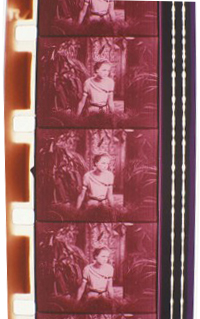
1936, black and white film
in 16mm, 20 minutes, sound on cassette.
Courtesy of the Walker Art Center.
ESSENTIAL CINEMA: JOSEPH CORNELL
Anthology Film Archives - 32 Second Ave, New York NY
Program 1: Saturday 22 December 5pm
Program 2: Saturday 22 December 7pm
$8
Joseph Cornell, a New York native and key American surrealist, is widely recognized for his “boxes” — small assemblages constructed mostly from found materials and various ephemera and housed neatly in small, rectangular boxes. His film output is less widely known than these sculptures, something that Cornell himself has attributed to his disinclination to publicly screen his work after an incident showing his early film Rose Hobart to a packed New York gallery in 1936. In town for a large Surrealist exhibition going on at the MoMA, Salvador Dalí, while making the rounds in New York and meeting the city's artists, attended Cornell's screening. Some time through the film Dalí, by then remarkably agitated, shouted insults at Cornell and overturned the projector in a fit of rage, later explaining, to the gallery owner, “My idea for a film is exactly that... I never wrote it down or told anyone, but it is as if he had stolen it.”
Sampling continental montage techniques, Cornell proposes an often gentler and more nuanced approach to the surrealist mode than many of his European contemporaries. Comparing a film like Rose Hobart to Buñel and Dalí's Un Chien Andalou is telling in this regard. Cornell's unabashed interest in beauty and his sidestepping of the violent potential in the surrealist project, as well as any direct movements towards the erotic or the amour fou, has resulted in a distinctly American body of work. Cornell may have been the first filmmaker to compose works made primarily from “found” or appropriated footage; Rose Hobart, for instance, is constructed almost entirely from footage refashioned from the 1931 jungle B-movie East of Bonero staring the titular actress. Cornell would show the silent film with a blue filter installed on the projector's lens (tinting the film) while playing the full-length of Holiday in Brazil, an accompanying record by Nestor Amarai — an exhibition technique that is, of course, a crucial component of the work and that Anthology observes when screening the film. After the incident with Dalí, it would be Jonas Mekas, Cornell's friend and Anthology's founder, current director, and prolific vanguard filmmaker, in the 1960s who would persuade Cornell to start showing his films again. Having made them part of the Essential Cinema series, Anthology shows these works now usually at least once a year, offering a chance for cinema goers to contemplate the sometimes opaque films that, like so much avant-garde cinema, reveal themselves further with each viewing.
Alongside Rose Hobart, some of Cornell's most important work are the films constituting The Children's Trilogy (1940s – 1969) — Cotillion, The Children's Party, and The Midnight Party — the first two of which are composed of nearly the same found shots of a children's party but spliced together in different order. These films reaffirm childhood as one of Cornell's leitmotifs, a theme that the artists seemingly dismisses by affirming his interest in creating work especially for children — his last major New York exhibition, in fact, was just such a show with work hung at a child's eye level and the museum staff serving pop and cake at the opening. This interest proves to be a revealing component of his life's work when examined in relation to the concerns and interests of other surrealist artists working at that time.
Several of Cornell's later films were completed posthumously by his disciple and fellow filmmaker Larry Jordan. Cornell mostly moved away from the collage or found-footage film in his later years, creating lyrical cinema and collaborating with other artists — most notably, perhaps, with the young Stan Brakhage, with whom he had created Gnir Rednow (1955), a film composed of the out takes from Brakhage's The Wonder Ring (1955), which Cornell had commissioned as a document of New York City's Third Avenue El before it was torn down in sections. Gnir Rednow was intended to be projected from either tail-end of the film, with the projector always running forward, and underscores Cornell and Brakhage's unique understanding of cinema as a material document rather than an ephemeral tool of representation.
Artists & Admin: New York Workspace Residencies
Dieu Donné - 315 W. 36 St, New York NY
Friday, December 21, 6:30 PM
Dieu Donné papermill and artists workspace host a panel this Friday at their midtown location surveying the various residency programs and related opportunities for visual artists in the city. The panel will be moderated by Cornell University's Patricia C. Phelps and will include artists and arts administrators in conversation (with some crossovers). Panelists will be artists Sonya Blesofsky, Noah Loesberg, Jean Shin, and Deborah Fisher (a representative of Socrates Sculpture Park with and regular Artcal Zine contributor), along with Felicity Hogan from the Lower East Side Printshop, Jeanne Gerrity from Smack Mellon, and Dona Warner from Dieu Donné. Although the press release is scant on details, the talk is likely to be as much useful advice for practitioners as an interesting look into the current state of smaller-scale institutional and non-profit patronage of the visual arts.
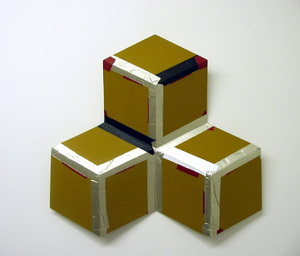
27 x 27 x 4 inches.
Courtesy Winkelman Gallery.
50/50
Ivin Ballen
Winkelman Gallery - 637 W. 27 St., New York NY
29 November 7008 - 5 January 2008
The more modest materials of artistic practice occasionally come under the purview of the artist and are elevated to the status of art. In the 70s, when Rauschenberg was short on materials, having just moved from New York to a small island near Florida, he looked around his studio and saw the clutter of packing supplies and other detritus. He took immediately to what was at hand, and the Cardboards, a series of works made from simple cardboard boxes, were born.
New York artist Ivin Ballen was also struck with a similar revelation: while transporting several of his earlier works across country, he looked in the back of his car and found the works, wrapped in plastic and cardboard, transformed.
Ballen set about investigating this new vision, and while his paintings are immediately reminiscent of those shocking Duchampian works of Raschenberg, they are anything but ready-made. Ballen’s process involves building a maquette from humble materials, casting them in fiberglass or resin, and painting them with trump l’oeil finish.
At first glance the effect is convincing, and without close scrutiny the objects appear to resemble so much contemporary art (see: Un-monumental at the new Museum) with their wacky assemblage construction. Upon inspection the paintings reveal elements of their process. “Tape” impresses rather than exudes, depths become protrusions, and the whole is a negative of its model. This reversal is characteristic of Ballen’s work—here the ready-made is actually the constructed—and more Étant Donnés than Fountain.
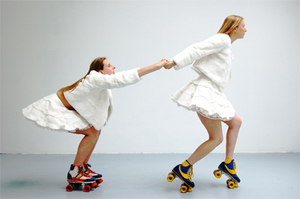
documentation by Iris Selke.Courtesy of Artists Space.
When Time Becomes Form
Solidly Grounded: Three works by TallBlondLadies
Artists Space - 38 Greene St, 3 Fl., New York NY
Tuesday 18 December – Saturday 22 December
Adjusted gallery hours: Tuesday-Friday 5pm-10pm, Saturday 12pm-5pm
Tomorrow marks the third installment of 12 week-long performances happening at Artists Space and curated by Marina Abramovic. The series, When Time Becomes Form, continues this week with three works by TallBlondLadies (Anna Berndtson and Irina Runge), performed over five days for five hours per day. TallBlondLaides explore notions of female identity and offhandedly opposed qualities in a gendered context (athleticism and beauty, for instance). TLB do this by creating compositions incorporating both movement, attire, and the banal props of everyday life. That the works are durational pieces, lasting the length of AP's adjusted gallery hours, attribute both a tension and a banality the work as bodies in strategic, sign-generating motion habituate even to the ascetic gallery space.
When Time Becomes Form will continue and develop at Artist Space over the next two and a half year. Participating artists will be members of Abramovic's Independent Performance Group, a loose collective of 42 artists from 22 different countries.
Please note the adjusted hours of the gallery.
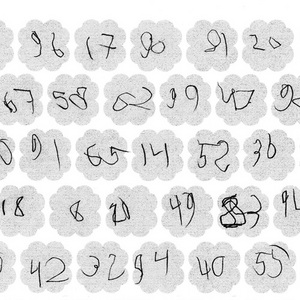
at Middle Press
Tonight, the Williamsburg Gallery Association presents its monthly Williamsburg Every 2nd: Art After Hours event, a chance to visit a number of the area's art spaces past usual closing hours and enjoy several related events. The WGA has organized transportation to Williamsburg from Chelsea on the ArtBus, a free ride departing at 6 and 8pm from the Chelsea Art Museum (556 W. 22 St). When in Williamsburg, be sure to stop by The Front Room Gallery (147 Roebling St) for the release party of free103point9's latest Audio Dispatch 7" Radio Ruido: False Rosetta, artist Tom Mulligan's homage to spy numbers shortwave radio stations. The release will feature live performances and Radio Ruido remixes by electro-acoustic composer Damian Catera, DJ Pause, and turntablist North Guinea Hills. After 9pm, as the galleries begin to close, Williamsburg green bar Oulu (170 N. 4th St, Brooklyn NY), in conjunction with alldaybuffet and the WGA, will offer $2 drinks to benefit the Performing Arts Middle School 113 in Fort Greene.
Following the weekend, at 6 to 9pm on Monday 18 December, Lower East Side's Cuchifritos gallery and project space host their annual fund-raiser and silent auction. Curchifritos has worked for the past six and a half years to offer exhibition opportunities to underrepresented curators and artists, and will be hosting its benefit at Sara Metzer Gallery in Chelsea (525-531 W. 26 St).
3 Modifications
Brody Condon
Virgil de Voldere Gallery - 526 W. 26 St, New York NY
15 November 2007 - 15 December 2007
As a teenager in search of amusing diversion, I occasionally tinkered with the programming code of popular computer games. Doing so required no expertise. I only had to augment or edit source files in directories associated with the game and then run the program. The results were unexpected and often bizarre: characters appeared headless and walked on air or the game scenery lay flat, rendered incomplete in crude polygons. My monkeying was primitive, random and pointless, but always satisfying. Because of my familiarity with basic game modifications ("mods," for short), I'm skeptical and dismissive of most such works appearing in contemporary art galleries. Brody Condon's sly gaming "interventions" and mods are an exception.
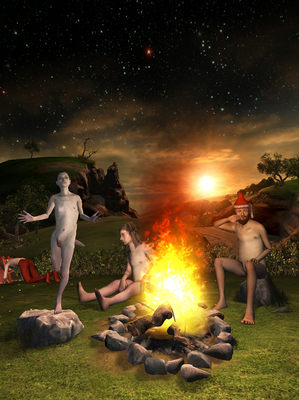
Self-playing computer game, custom computer.
Courtesy Virgil de Voldere.
In 2001, Condon repeatedly prostrated his character in Anarchy Online, a massively multiplayer online game. Condon's ritualistic worship of the omnipotent player (and viewer) takes place in an open square; around his character, fellow gamers move, engaged in more conventional, prescribed actions. For 2004's "Suicide Solution," Condon documented character suicides in over 50 first and third person shooters. Both gestures are artless, to be sure, but Condon's commitment to the virtual act ennobles the short documentaries; farce is transformed into pathos.
Neither "Worship" nor "Suicide Solution" are true mods, but KarmaPhysics{Ram Dass, created in 2005, qualifies. For this video projection, Condon reworks files and graphics from the game Unreal 2003 to produce a suspended, writhing pile of clones. As with his earlier projects, KarmaPhysics{Ram Dass transcends a simple premise, in this case becoming a hypnotic meditation on intellectual, physical and emotional suffering.
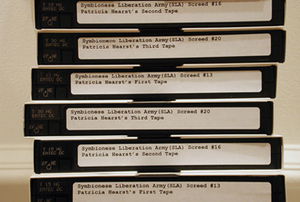
Liberation Army (SLA) Screeds #13, 16,
20 & 29 (detail), 2003, installation of multiple dubs.
Courtesy of the artist.
Untitled
Sharon Hayes
Orchard - 47 Orchard St, New York NY
7pm Sunday 16 December 2007
FREE
Artist Sharon Hayes presents a new work at Orchard this Sunday: ACT ONE of an as yet untitled audio cassette performance, continuing her ongoing investigation of speech and its various historical contexts. Often performing what she describes as "respeaking," Hayes's work makes the identity formation implicit in discourse explicit to her audiences. She does this in performance of various historical texts, usually speaking from outside her own personal experience or intimate knowledge, dislodging speech both popular and obscure from its historic moment and framework. In the Symbionese Liberation Army (SLA) Screeds tapes for instance, Hayes tries to speak from memory the text of four 1974 audio tapes made by Patty Hearst and the SLA, a radical, California political organization who had kidnapped Hearst in demand of a ransom that her wealthy family “feed all the poor people in California.” In her reading of the text, Hayes often misspeaks or recites incorrectly, to which an unseen group of people outside of the fixed video frame responds by aggressively correcting her. These videos are part of an open edition and distributed freely in gallery installations where they are labeled carefully and stacked against a wall. In this work, and many of her others, Hayes's own body and voice become a form through which the text — its own discursive form — is performed, both corroded by the passage the time and reinvested with meaning by ways of its new distributive framework.
Liz Craft
Marianne Boesky Gallery - 509 W. 24th Street, New York NY
November 17 - December 22, 2007
I was introduced to Liz Craft's work in 2002, as a student in a graduate seminar, sitting at a conference table in a dark room, while a professor of mine was desperately trying to explain the importance of taking risks. She showed us a handful of shaky progress snapshots of this sculpture, which would become Death Rider (Virgo).
The viewing conditions were not ideal. The sculpture was half-shrouded in a blue tarp with tools and a gantry surrounding it, but it still blew my mind a little because it was totally cheesy and, more dangerously, palpably earnest (and yet I didn't hate it!). It took the bored, knowing head nod that contemporary artists are supposed to achieve and turned it inside out. Instead, this thing charged at my eyes and made my heart bulge against my shirt, because it was made with so much love. And it confused me because it was totally balls to the wall and, at the same time tame, traditional, and studded with cliches. It's a traditional bronze statue of a skeleton riding a motorcycle for chrissakes!
I decided in that moment that Liz Craft must be some sort of empathic genius.
The edge in Craft's work comes consistently from doing what artists should never, ever do. Instead of resisting artworld cliches like seventies stuff, unicorns, or what would become "Banks Violette Gothic," she charges into them. Instead of distancing herself from the language and materials of traditional sculpture, she depends upon them. Instead of relying on irony, she commits to a vision. The result is work that is fantastically fresh, but in no way "new." It's fresh because it's wrong; because it obviously delights in fights against art history and tradition, against cliche, against what sophisticated art viewers expect to see.
So it should not surprise you that I had expectations for this show that's currently up at Boesky. In fact, I thought I knew what I was going to write for this review before I even walked into the gallery. Instead, I am finding that I have to muddle through my hero worship to arrive at a place of opportunity. The show at Boesky is not very good; but at least it's not very good in ways that are meaningful to lovers of Liz Craft's tendency toward risk and helpful to risk-takers everywhere, who must know by now that it's no fun if you can't fail!
Craft's untitled show consists of large, medium, and small aluminum architectonic forms that are studded with windows, fireplaces, and other kinds of (mostly square) holes, which function to create inside and outside spaces. Inside these holes are cast interior spaces like flower vases or figures floating in water, also aluminum, welded to the larger architectonic forms. These are not mini-installations or assemblages. Everything is the same material and welded together, so each sculpture is a distinct spatial expression rather than a collection of relationships. Each piece is painted a supercool glossy white, and this emphasizes the tension between inside and outside. All of this makes the gallery, of course, into the largest of these container spaces; as time goes on you may well become aware that you, too, are inside a larger instance of these modeled spaces, the gallery enclosing you and the work in a Russian nesting-doll style configuration.
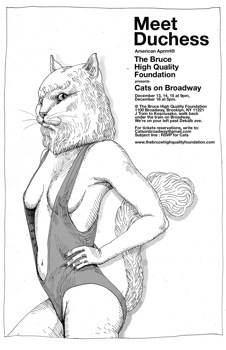
Cats on Broadway
BRUCE HIGH QUALITY FOUNDATION
The BHQF Theatre – 1100 Broadway, Brooklyn NY
9pm 13, 14, 15 December 2007
5pm 16 December 2007
$10
Anonymous, shadowy New York-based collective Bruce High Quality Foundation (self-proclaimed estate arbiters of late, fictional social sculptor Bruce High Quality) present Cats on Broadway, a four day theatre performance on the border of two quickly gentrifying Brooklyn neighborhoods. The performance follows the group's latest work at Exit Art which came down mid-November: Beyond Pastoral, a fifth-scale model of a BP gas station with working lights powered by some several hundred lemons and limes left to rot on the gallery floor, arranged in a glorious BP helios and feeding electrolytes to the gas station lights via a potato-clock like mechanism. The piece's accompanying wall-text was a pastiche of pop culture and historic references that elliptically discoursed on the work's narrative concerns — something of an ambient story about a developing power capacity and need, a new school of corporate environmentally-concerned posturing, a colonial etymology of the two fruit varieties powering the installation, and a mélange of historical facts and pseudo-scientific assertions. While the points hit on come across a little strong at times, the work certainly didn't suffer from the spare, poetic text which provides as much a framework for the piece as a challenge to the more straightforward and literal quality of the material installation.
Likewise, the Cats... website promoting the latest Bruce High Quality efforts features two short texts about a Great Depression-era Harlem race riot and Voodoo Macbeth — a federally funded, Orson Welles directed, postcolonial adaptation of Shakespeare's Macbeth set in Haiti and performed by an all-black Harlem cast that was organized just a year after the cited riot. Evoking the questionable play to contextualize their own contemporary production, BHQF seems to operate in a mode of an ironic traipsing around social issues while remaining politically invested in... something. The faux American Apperal ads plastered across the website communicate the usual Foundation tactic of an appropriation of forms (commercial in this case) as we see wayward twenty-somethings revel in feel-good monochrome designs that signal a new era of abstracted branding — a clothing line identifiable without a logo, but ubiquitous in its aggressive advertising to transplanted, jet-setting urban youth, the harbingers of gentrification. What better symbol with which to pair this corporate giant than Cats..., the commercially tremendous Broadway musical turned tourist trap that lasted for some 18 years, and ran parallel with corporate and municipal efforts to “clean up Broadway” for big business? BHQF's Cats on Broadway will be a series of musical vignettes structured around “original arrangement of a popular song performed by the Bruce High Quality Orchestra to situate a different character in the neighborhood (shopkeeper, minister, hoodlum, college student, prostitute, etc.) contextualizing their individual circumstances within themes of nostalgia, rage, sex, family, labor, redemption, etc.”
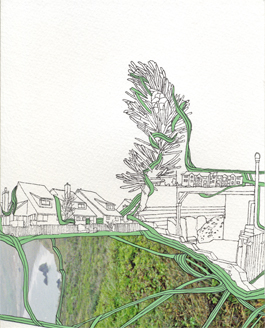
Xerox transfer and gouache on paper, 7 x 8.5 inches.
Image reproduced from the Artists Space Night of 1,000
Drawings invite.
City Reliquary Museum and Civic Organization Fundraiser
7-9pm Monday 10 December
Automotive Highschool Auditorium –
On Bedford Ave. across from McCarren Park in Williamsburg
$30
On Monday, 10 December, the City Reliquary Museum and Civic Organization, a self-described for-the-people not-for-profit alternative history museum will be hosting its annual fundraiser. Located in Williamsburg at Metropolitan and Havemayer, the Reliquary Museum was originally conceived as a sidewalk museum and window display case where personal collections from community members could be displayed along with other local ephemera. Since then the organization has blossomed into a full non-profit that seeks to serve the people of New York City as a site for public events and where local history is celebrated and constituted by exhibitions of local artifacts. Admission to the fundraiser is $30, at which author Lawrence Weschler and sportswriter Paul Lukas will speak, while filmmaker JL Aronson will show excerpts from a new documentary about a South Williamsburg rooftop pigeon keeper. Admittance to the dinner afterwards costs $125, and will be hosted by Bamonte's, one of Williamsburg's historic Italian resaurants — RSVPs for the dinner are due tonight, and can be emailed in to rsvp at cityreliquary dot org.
Holiday Party and Reception at The LES Print Shop
6-9pm Wednesday 12 December 2007
306 W. 37th St, 6th Fl.
FREE
Night of 1,000 Drawings
Thursday 13 December 2007
Artists Space - 38 Greene Street, 3rd Fl., New York NY
$10
On Wednesday, 12 December, The Lower East Side Print Shop holds its annual holiday party and reception, and will feature an art sale of donated works to support the printshop, as well as a 10% discount on all other works on sale. Meanwhile Thursday, 13 December, is the date for Night of 1,000 Drawings, the Artists Space annual benefit auction. Admission to Night... is only $10 and offers patrons a chance to purchase original drawings by both emerging and established artists at $35-$60 a piece. Admission also includes access to an open bar from 7:30-9pm.
Young Collectors: A Panel Discussion
Aperture Foundation – 547 W. 27 St, New York NY
6:30pm Tuesday 11 December
FREE
Finally, on Tuesday 11 December Aperture Foundation hosts a panel on young collectors, with a focus, naturally, on collecting photography. The panel will be moderated by WM Hunt of Hasted Hunt Gallery and will include panelists Mike Hoeh of Modern Art Obsession, art consultants David Kronn and Gael Zafrany, and designer Todd Oldham.
I-Be AREA
Ryan Trecartin
New Museum - 235 Bowery, New York NY
3pm, 8 December 2007
$Museum Admission ($12)
Nowadays: A Conversation and Screening with Ryan Trecartin
New Museum - 235 Bowery, New York NY
7pm, 14 Decembet 2007
$8
After the sort of critical reception Ryan Trecartin received this fall when he presented his new feature-length experimental video I-Be AREA at Elizabeth Dee Gallery in Chelsea (along with a room of some less remarkable installations that may have once had previous lives as set props) it isn't surprising that the New Museum has asked the young artist to come and show his work to New York audiences again, this time at the museum's new Bowery location. This Saturday the New Museum screens I-Be AREA, offering a chance for viewers to see the work in a more cinematic setting than last season's gallery installation. Next Friday, 14 December, other Trecartin videos and excerpts will be screened with the filmmaker and Rhizome director Lauren Cornell in tow to help lead the discussion with Trecartin on his own practice and work.
Since Dennis Cooper wrote on the artist's popular A Family Finds Entertainment in Artforum's January 2006 issue, many critics have been echoing Cooper's comparisons of Trecartin to the likes of George Kuchar, Kenneth Anger, and Jack Smith. The more interesting thing about Trecartin though, is that he taps into a sort of late 20th century milieu of having come of age on the nascent social platforms of the Internet. His negotiations with the culture of constant virtual presence and a mandatory system of self-representation (quickly moving towards a system of self-presentation) constitute much of the artist's conceptual heft. And as a kid who grew up online, so far Trecartn has practiced the distribution of his work (a crucial component of any media artist's practice) as a natural extension of where his interests and legacy lie: YouTube, of course, where nearly his entire video oeuvre still remains freely available for low-res streaming (and, to be fair, official and exhibition copies are distributed by Electronic Arts Intermix). I-Be AREA, the artist's longest work to date — and a kind of mature and natural successor to A Family... — is his first video that, judging by its limited-edition status and the fact that the distribution is controlled exclusively by Trecartin's gallery, won't be appearing on the artist's YouTube account any time soon; all the more reason, one imagines, to catch it at the New Museum.
Ensemble
The Institute of Contemporary Art, University of Pennsylvania
118 South 36th Street, Philadelphia, PA
7 September - 16 December 2007
Thwang, bonnngggg, thwap, clink-clink, and "Hello, Yoko."
These are just some of the sounds you'll hear and one of the things you might get to say at Ensemble, a show of sound art curated by Christian Marclay at the ICA in Philadelphia. Marclay's has let the sense of whimsy that informs much of his own work do the same for the exhibition, letting that spirit run deliciously rampant for this show of 27 artists.
But as usual it's not all fun and games with Marclay. The assault of so many pieces in one room provides a tension that soars and eases depending on the number of visitors in the room. More subtle works share the space with louder, one-trick-ponies (but what tricks!). Some pieces are interactive while some are on their own; yet, all roads lead to sound. The works that are interactive (about half of them) imply that the titular ensemble isn't complete without an audience.
The doorway to this sonic feast is Mineko Gimmer's gentle, but hefty, gauntlet, Bamboo Forest. In sharp contrast directly in front of the entryway is Jon Kessler's paranoid Sniper #10, in which surveillance technology is used to immediately recontextualize the image of the viewer to disorienting effect. Two other unsettling, albeit hilarious, works are Dennis Oppenheim's Attempt to Raise Hell and Yoshi Wada's The Alarming Trash Can, both of which were a blast to watch to observe as museum goers discovered the surprises they held. Less assaultive surprises await in Doug Aitken's many timbred K-N-O-C-K-O-U-T, and Katje Kölle's Staccato (americano). Evan Holloway's Victory Song is the simplest and most elegant of Rube Goldberg's with only one action involving a brass ball rolling on a rack with the sound focused through a phonograph horn. The spirit of Ensemble is best exemplified by Yoko Ono's Phone Piece, a phone on the wall that Ono calls occasionally to speak with whoever happens to pick up the receiver.
Yellowcake
Thomas Demand
303 Gallery - 525 W. 22 St, New York NY
3 November - 22 December 2007
Yellowcake, the show currently open at 303 gallery, marks something of a departure for Thomas Demand. In the past the artist has largely confined himself to images already in some sort of circulation, often ones that he has himself encountered elsewhere. His technique of recreating, in cardboard and paper, a given photograph's subject, and photographing it afresh, so to speak, has thus chiefly served to intervene and complicate an already operative sector of the representational economy. In this way, Barn (1997) simultaneously highlights the seams on the construction that is 'Jackson Pollack,' and what that same signifier manages to leave out, presenced here, perhaps, by the light pouring in the windows and pooling on the floor.
The consistently satisfying thing about this delicate dance of absence and presence running through Demand's work is that it's meticulously reflected in his methodology. Rather than simply gesturing, as many do, towards a body of ideas regarding structure, construct, representation, and the like, Demand takes no chances, producing for our consumption the entire spectacular cycle - each and every time. This diligence prevents him from merely rehearsing the parable of the photo under late capitalism, say, or glossily demonstrating yet again the numerous deceits of official history. Instead, this commitment allows him to set these truths to work on lived experience, returning it to us more estranged, and thus, more familiar, than before.
What makes Yellowcake such a departure for Demand, and what makes it so compelling, is that he has chosen for his subject something which is not only outside the dominant economy, but strategically so, such that its appearance in ordinary photographs alone constitutes a sufficient presentation in the hands of a lesser artist. This imagery would no doubt seek to supplement the fraudulent discourse regarding the American invasion of Iraq with actual, documentary photos of Niger's Embassy in Rome; from which the letterhead used to fabricate the evidence of Hussein's alleged attempt to purchase of weapons grade uranium (yellowcake) was stolen. In Demand's hands, however, this act of demonstration, this voici, is much more complicated than any simple speaking of truth to power.
ZINE
HOME
TIPS / COMMENTS
CATEGORIES
CONTRIBUTORS
- Greg Afinogenov
- B. Blagojevic
- Adda Birnir
- Susannah Edelbaum
- Julie Fishkin
- Paddy Johnson
- Jessica Loudis
- Christopher Reiger
- Andrew Robinson
- Peter J. Russo
- Blythe Sheldon
- S.C.Squibb
- Hrag Vartanian

